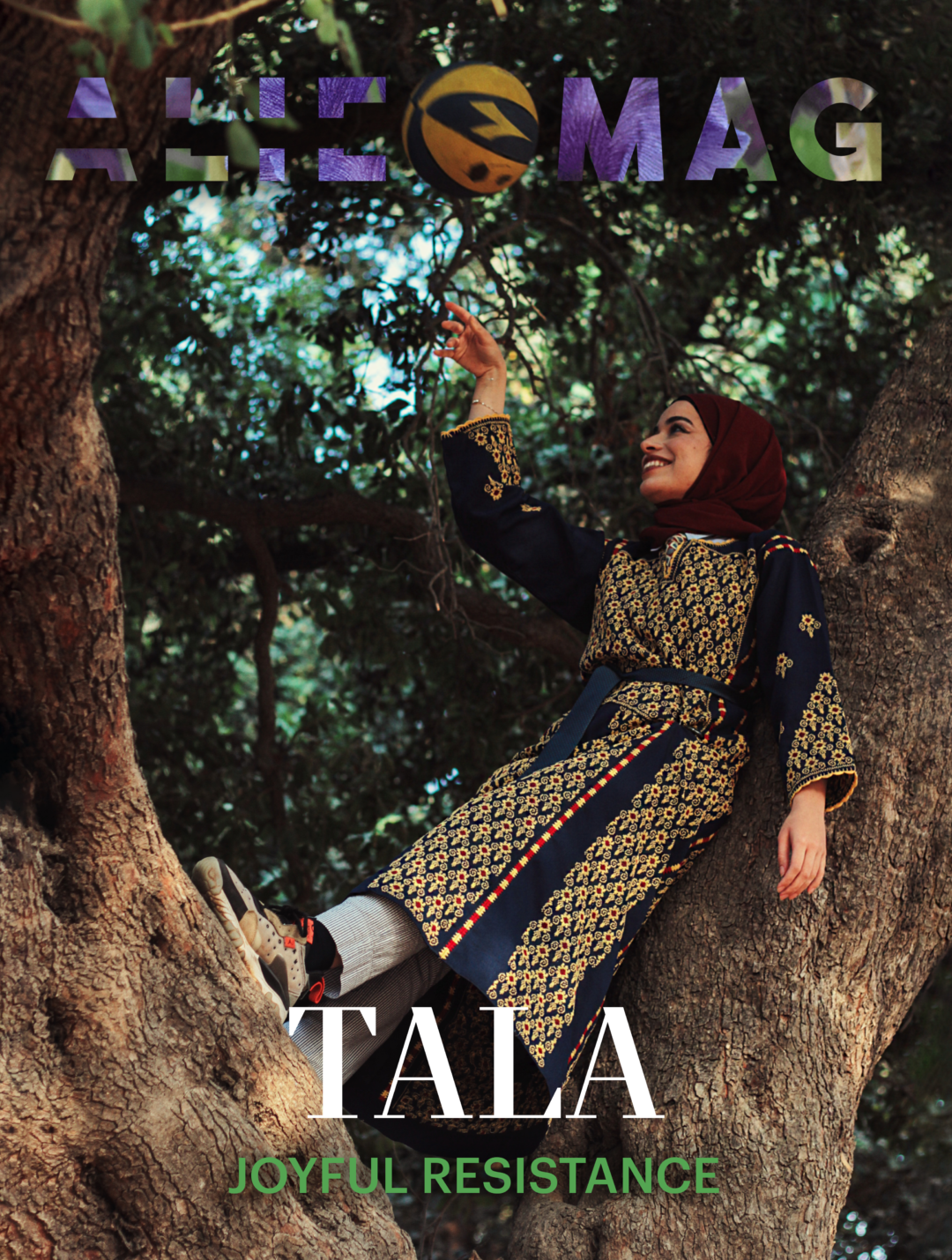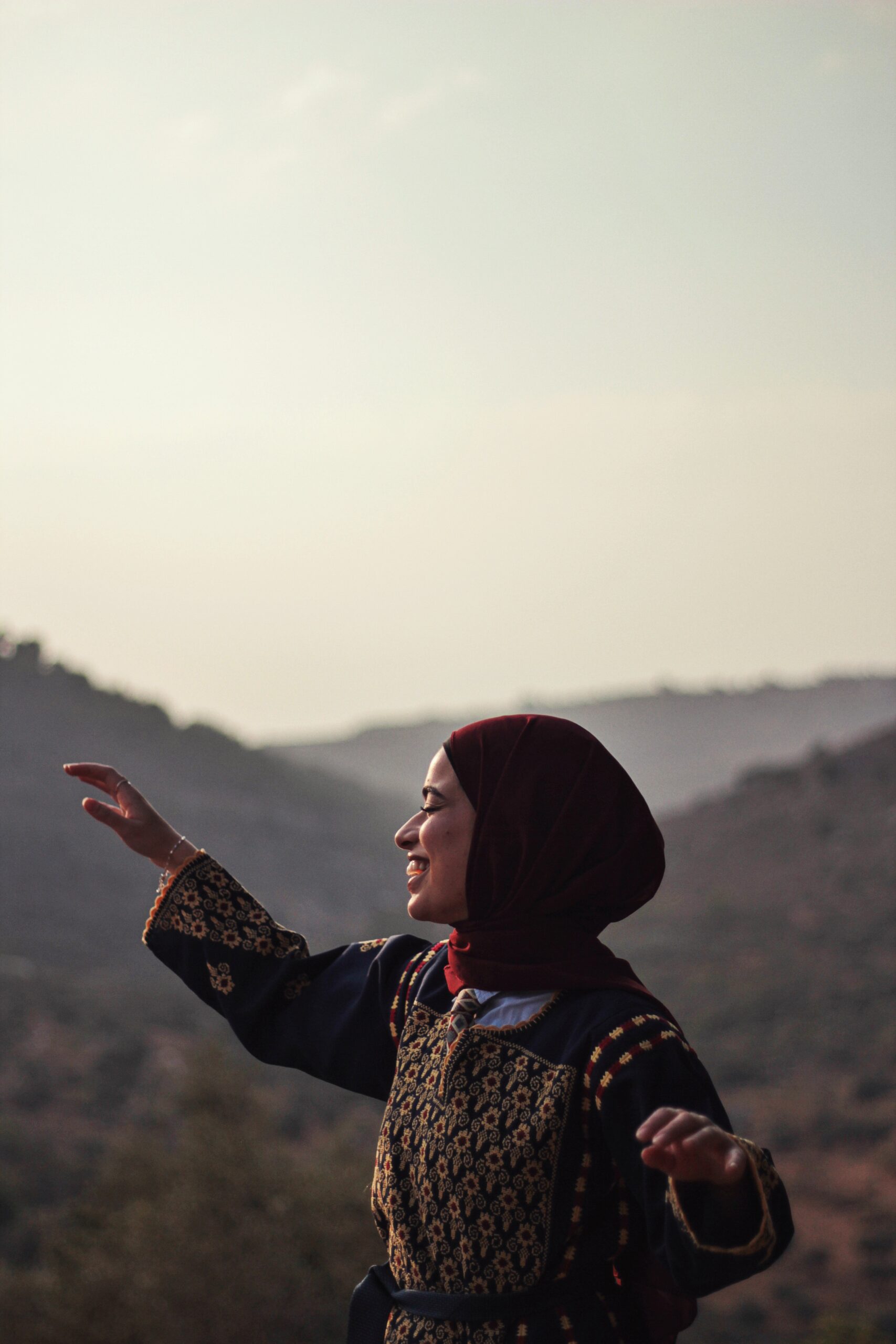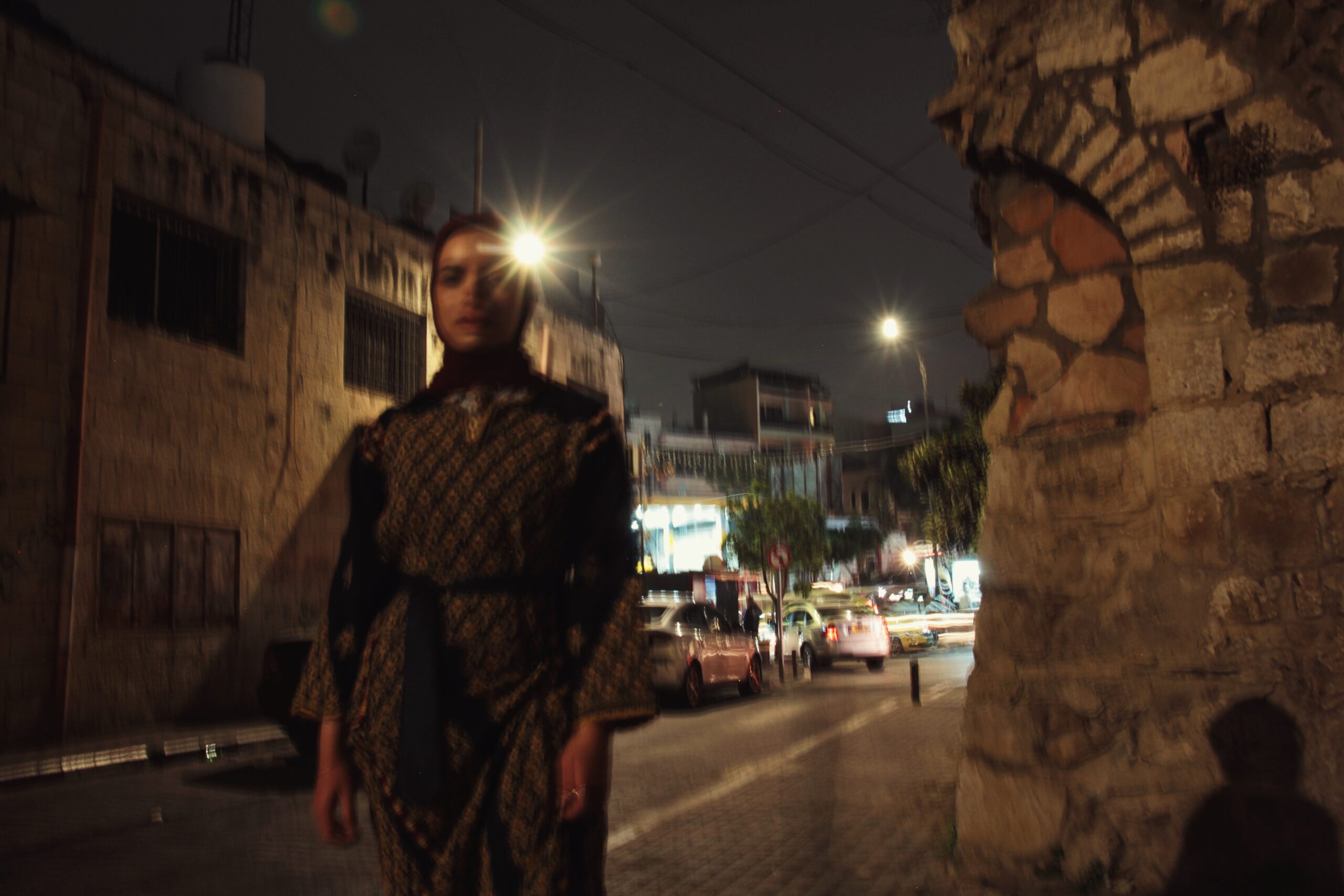ENGLISH VERSION BELOW // Als je de eer hebt gehad om haar hier in Nederland te leren kennen weet je dat aan haar vreugde niet te ontkomen is. De altijd vrolijke Palestijnse Tala Abdalhadi die in het studiejaar 2021-2022 met een beurs een jaar aan de Koninklijke Academie van Beeldende Kunsten (KABK) heeft gestudeerd is onze coverster van deze editie. Deze jonge kunstenares beweegt zich vreugdevol voorbij niet alleen staatsgrenzen, maar ook disciplinaire grenzen, een manier van werken die niet losstaat van haar Palestijnse identiteit. De grenzen die haar zijn opgelegd durft Tala creatief te navigeren, om zo niet alleen voor haarzelf maar ook voor anderen deuren te openen en de mogelijkheden in de tussenruimtes zichtbaar te maken.

Redacteur Yusser Salih
Foto’s Tasnim Khlaif
Styling Tala Abdallhadi
Mua Raghad Khader
Art dir. Tala Abdallhadi
Muse Tala Abdallhadi
Foto ass. Hasna Abdalhadi, Tayma Abdalhadi
Graphic design Lamiae El Hajjaji
Met dank aan Stimuleringsfonds voor de Creatieve Industrie
Tala werd geboren tijdens de tweede intifada – een van de grote Palestijnse opstanden tegen Israël – in 2000. Terwijl haar gezin altijd in Birzeit heeft gewoond moest haar moeder voor Tala’s geboorte naar het ziekenhuis in Jeruzalem. Daar was het enige ziekenhuis die in bezit is van drie couveuses. Haar moeder – zwanger van een drieling – kon op medische gronden de door het Israëlische leger opgezette controleposten passeren naar Jeruzalem. Haar vader moest daarentegen een andere manier vinden om de zware checkpoints te omzeilen en bij de geboorte van zijn dochters te zijn. Uiteindelijk lukte het hem om naar binnen gesmokkeld te worden door een vriend die in het bezit was van een gele kentekenplaat*.
*Auto’s met gele Israëlische kentekenplaten worden in tegenstelling tot auto’s met groene Palestijnse kentekenplaten moeiteloos doorgelaten.
Zo speelt het creatief omzeilen van grenzen al sinds het prille begin van Tala’s bestaan een grote rol in haar leven. Als rode draad komt deze houding ook in haar kunstpraktijk naar voren. Met haar speelsheid en grote glimlach beweegt Tala zich vrij tussen disciplines door om de grotere vragen in het leven te onderzoeken. Bijvoorbeeld in haar werk (onderdeel van een groepsproject) Territorial, een interactief spel dat community building inzet als middel tegen onrecht op het gebied van huisvesting, en inzicht geeft op hoe mensen zich kunnen gedragen als de structurele omstandigheden veranderen.

Ze houdt van beweging, heeft drie jaar basketbal gespeeld en doet aan pilates, zwemmen en hardlopen. Al deze verschillende physicalities vormen hoe ze de wereld ziet en hoe ze connecties maakt, vertelt ze. Haar praktijk is dwalend, verhalend en verbindend. Wanneer ze zich eenmaal richt op een onderwerp vormt er in haar hoofd een kettingreactie aan connecties. “Warning, stop me or detangle me”, zegt ze. “Al deze dingen openen zoveel deuren in mijn hoofd, het is een soort popcorneffect.” Terwijl dit gezien kan worden als een chaotische tendens belicht het ook haar drang om altijd het gehele plaatje te zien, om de inherente connecties met de rest van de verhalen en de rest van de wereld niet te vergeten, en de verstrengeling in het leven te waarborgen.
Dat ze zich bewust moet zijn van de vele verschillende lagen waar ze zich tussen bevindt ziet ze als de kracht van haar unieke positie. In de context waarin ze zich begeeft wordt er veel nadruk gelegd op onderzoek en dit draagt Tala enthousiast mee. “Onderzoek is ons middel. Palestijnen zijn over het algemeen beter in onderzoek dan in uitvoering, want dat is het middel dat we tot onze beschikking hebben. Zo open ik de wereld en krijg ik toegang tot waar ik toegang toe wil hebben.” Haar ouders hebben in haar opvoeding veel moeite gedaan om zelfstandig en kritisch denken te stimuleren. “Ze wilden dat we onze eigen positie begrepen, zelf kozen hoe te denken en de ruimte namen om na te denken over wat we precies wilden doen in de wereld.”


Toch voelt ze soms dat ze te wetenschappelijk is als kunstenaar, dat ze conceptueel en theoretisch sterker is dan in de uitvoering. Dit gevoel werd benadrukt toen ze na veel hulp en motivatie van haar docent Omar zich in Nederland op de kunstacademie begaf, een plek berust met alle middelen om mee te experimenteren. In tegenstelling tot haar schoolgenoten wiens maakproces hen makkelijk af leek te gaan, had Tala veel moeite met het uitwerken van haar ideeën. De nadruk op onderzoek die ze vanuit haar leefwereld in Palestina meedraagt komt immers niet alleen voort uit de noodzaak om de brutaliteit waarin ze leeft te begrijpen, maar ook door een direct gebrek aan andere middelen.
“Ik besefte me dat – doordat ik opgegroeid ben in Palestina – het niet even makkelijk is voor mij om dezelfde voorzieningen te krijgen. De mensen die ik hier in Palestina zie, de manier waarop we hier tegenwoordig omgaan met dingen, is meer intellectueel. Je zou bijvoorbeeld niet buiten iemand zijn eigen kledingkast zien bouwen. Wie heeft daar hier tijd voor? Vreedzamere landen hebben middelen, veiligheid en minder externe factoren om je als burger zorgen over te maken. Je kan dat niet vergelijken met de realiteit van de mensen hier. Wij maken ons zorgen over andere dingen. De mensen hier maken zich geen zorgen over kleding, maar over hun levens. Ze maken zich zorgen over hun toekomst, over hun kinderen. Dus je kan die vergelijking eigenlijk niet maken, maar ik kan het niet helpen dat ik dat verschil toch opmerk. Ik zou willen dat het een eerlijke vergelijking was…“

Deze realiteit zorgt ervoor dat Tala het niet kan veroorloven om haar kunstpraktijk niet haar alles te geven. “Ik moet zoveel andere stappen zetten om op een niveau te komen waarop ik daadwerkelijk zichtbaar ben.” Er zijn zo veel lagen waar ze zich bewust van moet zijn om de barrières van haar omgeving te overstijgen, dat ze niet anders kan dan een duizendpoot zijn met een been in elke discipline. Er zijn zoveel politieke en socio-economische grenzen die actief zijn opgezet door onder andere de Israëlische bezetting, dat voorbij de grenzen denken en dromen een vorm van verzet wordt. “Het doorbreken van disciplines is een manier om door mijn eigen realiteit te breken en te weigeren te erkennen dat dit kader dat voor mij is getekend, alles is wat er is. Mensen wilden dat ik een discipline inging, mensen wilden dat ik iets definieerde en ergens in gedefinieerd werd maar ik wil mijn positie in de tussenruimtes eerder als een kracht dan als een nadeel benadrukken.”
In de tussenruimtes houd Tala zichzelf staande als ambitieuze onderzoekende kunstenaar die met haar popcorn brein de hele wereld wilt omvatten en al zijn mogelijkheden wilt openen. Haar drang om mensen te mensen begrijpen, verbinden en kansen te creëren voor haarzelf en anderen is misschien ontstaan uit het ongelijke speelveld waar ze zich op bevindt maar overstijgt het tegelijkertijd ook. Met onbegrensde dromen staat Tala hier voor ons. Ze weigert haarzelf in te laten kaderen en durft niet alleen te dromen maar ook zichzelf actief te bewegen voorbij de vele grenzen die haar zijn opgelegd. Dit is Tala Abdalhadi’s vreugdevolle verzet.
Bezoek Tala’s website om je verder te verdiepen in haar werk
ENGLISH VERSION BELOW
By moving in between borders, creative Tala Abdalhadi (22) finds her joyful resistance
If you have had the honor of meeting her during her time in The Netherlands you would know that there’s no avoiding her joyful character. The always merry Tala Abdalhadi- who went to school at the Royal Academy of Art in The Hague in the year 2021/2022- is our cover model for this edition of Alien Mag. The young Palestinian artist joyfully moves between nations’ borders and borders in different career fields. A skill that fits her identity as a Palestinian: knowing how to navigate borders is a characteristic that every Palestinian learns to possess. Tala moves beyond the borders put upon her in creative ways, so as to open not only doors for herself, but also for others.
Tala was born during the Second Intifada (uprising)- one of the big Palestinian resistance movements against Israel- in 2000. Tala’s family had always lived in Birzeit, but for her and her sister’s birth, because they were a triplet, her mother had to go to a hospital in Jerusalem as it was the only hospital with three incubators. Based on medical grounds, her mother was granted permission to pass the checkpoint set up by the Israeli army. Her husband wasn’t allowed to pass and had to find a different way to cross the heavily guarded checkpoint to witness the birth of his three daughters. With the help of a friend -who owned a yellow Israeli license plate- they managed to smuggle him into the city.
Borders, and the ability to find ways to creatively bypass them, has been a big part of Tala’s existence from the moment her life was about to start. It’s only natural that it translated into her art and creations as well. With her playful energy and big smile, Tala moves freely between different fields to answer the big questions in life. An example of this is found in her called Territorial; a group project that she worked on with 2 other students. Territorian is an interactive game that uses community building as a tool against injustice when it comes to housing inequality, and offers insight into the changes in people’s behaviour when circumstances change.
She loves to move and be active; she’s been playing basketball since middle school, does pilates, swims and runs. All these physicalities shape the way she looks at the world and how she forms connections. “Warning, stop me or detangle me”, she says in our conversation. It reflects the rush of thoughts and ideas, with a hint of chaos as a result to the urge in her to research the bigger picture; the inherent need to not forget the connections to storiesand the people of the world, and to keep up with the entanglements of life. “All these thoughts open up so many doors in my mind, it’s like this popcorn effect”.
Here lies the strength of Tala’s position. In the context that she lives in, emphasis is put on doing research and asking questions. And Tala? She enthusiastically participates. “Research is our tool. I think a lot of Palestinians tend to be better at research than execution, because that is the resource that we have. That is how I open the world, that’s how I access what I want to access.” Growing up, her parents put a lot of effort into encouraging critical thinking. “They wanted us to understand our own position,choose how to think and take a moment to think of what we wanted to do [in the world].”
Regardless, she sometimes still experiences the feeling of being too scientific for an artist, and that she’s stronger in the conceptual and theoretical, rather than the implementation, despite her love of making. This feeling was amplified when, with help and motivation from her mentor Omar Nasser-Koury, she moved to The Netherlands to study at the Royal Academy of Art. A place that had all the tools to be able to experiment freely. She wanted to jump into the challenge of a making-intensive environment. In comparison to her classmates, it was a challenge for Tala to technically execute her ideas into her art. Bit by bit that barrier started chipping away. The importance of research that she learned from growing up in Palestine didn’t only manifest from the necessity to understand the brutal regime she lived with, but also from the lack of resources.
“I realized, growing up in Palestine, that it’s not easy to get the same facilities. The present day, the people I am seeing here in Palestine right now, how we interact with things, is more intellectual. You wouldn’t go outside and see someone building their own wardrobe for instance. Who has time for that? More peaceful countries have resources, they have security, they have all of that. You have less to worry about from the outside. You cannot compare that to people here. We are worrying about other things. People are not worrying about building daily objects, they are worrying about their lives, they are worrying about their futures, about their children. So you can never make that comparison but you cannot help but notice it and wish that you could. Like, hey I wish… “
Her reality doesn’t permit her from not putting everything she has into her creations . “I have to take so many different steps to get to a level where I’m actually visible”. There are many political and socio-economic boundaries that have actively been put up by the Israeli occupation. Thinking and dreaming beyond those boundaries is seen as a form of resistance. Tala is aware of the many layers she encounters and has to be a jack of all trades to get past them.
“Breaking through disciplines is a way of breaking through my own reality and refusing to acknowledge that this square that is drawn for me is all that there is. I feel the pressure to go into a discipline, to define and be defined in something and I want to highlight my ‘being in the in-between’ as a strength rather than as a downside.”
Visible and with joy, Tala stays firmly rooted as an ambitious, researching, and curious artist, with a brain that is constantly inspired that new connections pop like popcorn. She is a person who wants to understand the world and explore all it has to offer. To understand people, connect with others, and create opportunities for herself and those around her; a character trait developed on the unlevel playing field she was put on. But it’s a trait that she has managed to take further than her surroundings allowed her to.
Visibly she stands before us in her full complexity. She refuses to put herself in a box and is willing to not just dream, but to actively move beyond the many borders that have been put up against her. This is Tala Abdelhadi’s joyful resistance.
Visit Tala’s website to further immerse yourself in her work